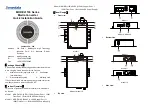
17
800-523-6049
|
www.rldrake.com
TS Bitrate:
User must enter in the bitrate for the output TS. Options are 19.39 Mbps, 38.8 Mbps (default) and
Custom. The Custom TS bitrate can be set from a minimum of the sum of the video and audio bitrates plus TS
overhead to a maximum of 38.81070 Mbps. An error message (shown below) will be displayed if the TS bitrate
entered does not support the configured audio/video bitrates.
“Error! The total configured Audio/Video bitrates (including TS overhead) exceeds the selected TS bitrate”
Modulation Mode:
allows the user to select the modulation mode. Options are: Reserved, Analog, QAM64,
QAM256, 8-VSB, and 16-VSB.
Out of Band:
An out-of-band (OOB) is a channel which is the combination of the forward and reverse OOB
channels. When a cable virtual channel is flagged as being out-of-band, it is carried on the out-of-band channel.
Options are Enable and Disable. When Enabled, assigns the OOB bit in the TS packet and labels the TS as out-of-
band.
NOTE:
As per the ATSC and Cable standards, the Modulation Mode and Out-of-Band fields are
required to be assigned in the TS packet. Selecting the above two fields would allow the TS packets to
be compliant with industry standards, but would not affect the input or output configuration of the unit.
In the section entitled
“Output Mapping”
, the user can select and configure the following parameters for the output
TS indicated by
“TS - QAM”
under gray header:
Input:
indicates the program selected by the user. It includes the Input video source, and audio source.
PID:
user must enter the PID value for each stream. PID (Packet Identifier) values are embedded by the content
provider in the MPEG-2 stream to identify tables and programming packets.
Program Number:
user must enter an output program number. The PMT (Program Map Table) provides
information for program present in the transport stream such as program_number, and the list of the elementary
streams (audio, video or data). The range is 1 to 65535.
Short Name:
user must enter the short name of the channel. Up to 7 alphanumeric characters are allowed.
Major Channel:
user must enter the major channel number for the output program. The range is 1 to 99 for
Terrestrial and 1 to 999 for Cable.
Minor Channel:
user may enter minor channel number for the output program. The range is 1 to 99 for Terrestrial
and 0 to 999 for cable. NOTE: When zero (0) is entered as a minor channel, it sets the encoder to provide a one
part virtual channel number as entered in the major channel field. For example, a major channel of “205” with a
minor channel of “0” will be displayed as “205” on a TV. A major channel of “205” with a minor channel of “1” will
be displayed on a TV as “205-1”.
Unit Configuration
Main Tab: TS Configuration Screen
(continued)
The PID value must be unique in an output stream. If a duplicate PID exists, assign a different PID
in the range of 48 to 8176 (recommended range provided by the International Standards)
2
3
4
5
6
7
8
9
10
Remember to click on the SAVE button to apply the new values/configurations.
















































